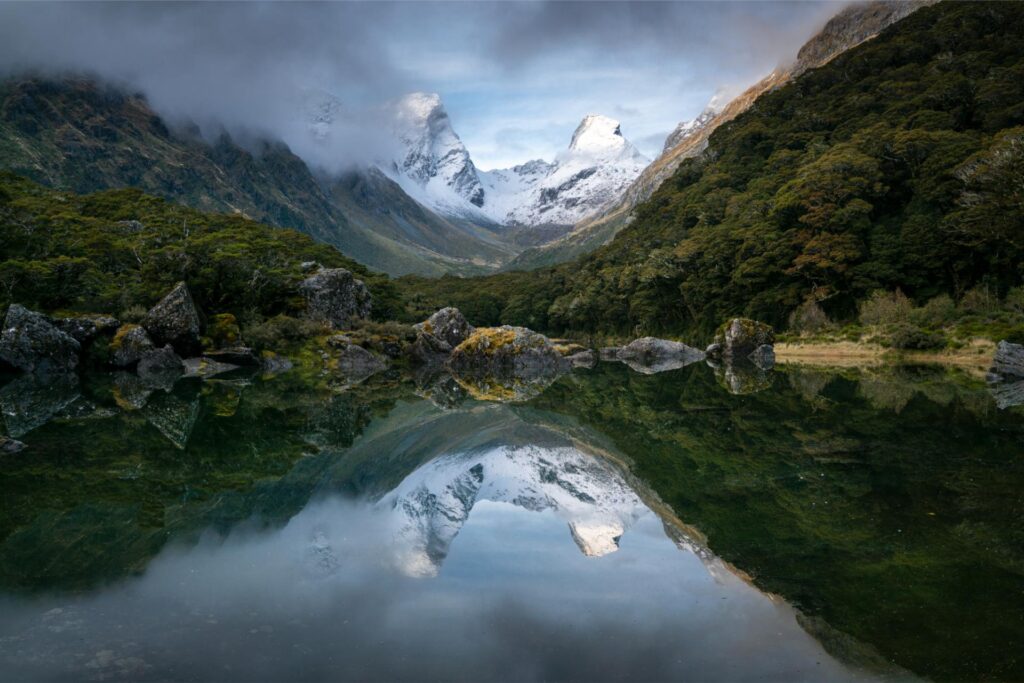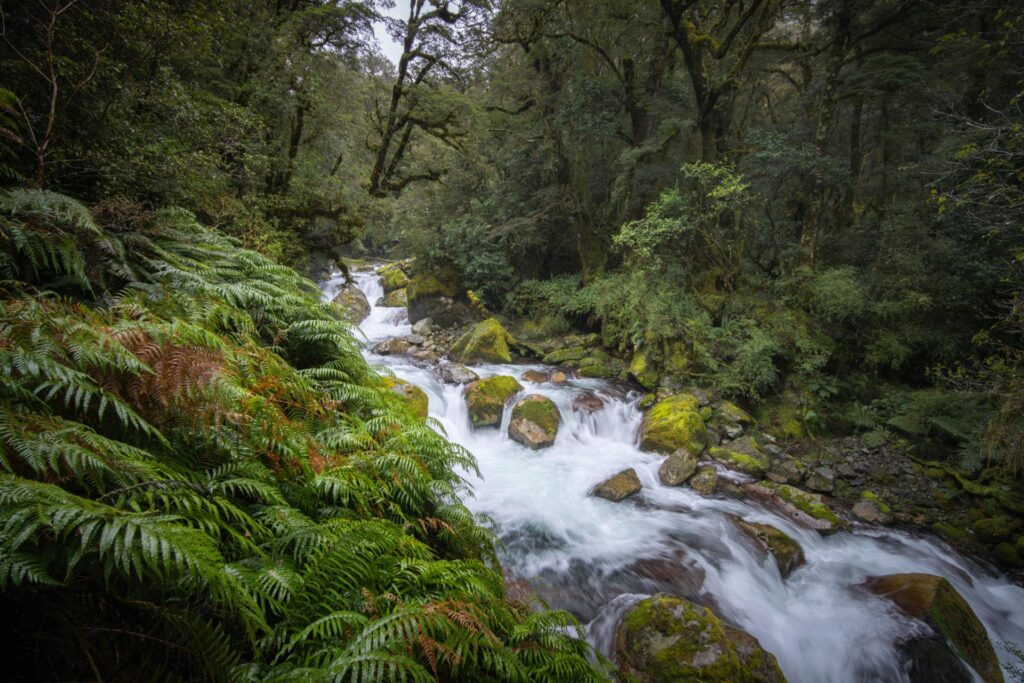Hazards and Risks
The natural beauty and diversity of New Zealand’s landscape are a critical part of what makes our country a popular visitor destination. However, the same diverse and dynamic landscape also presents a range of natural hazard risks, and Piopiotahi Milford Sound is no exception.
We want you to have a safe and enjoyable visit, so it’s important to be aware of potential hazards in the area, stay up to date with weather conditions and relevant travel advisories, and be prepared for anything.
Fiordland is the largest, most isolated National Park in New Zealand and the weather can change rapidly. Prepare for all conditions, from beautifully sunny to cold temperatures, snow, strong winds and heavy rain. They can happen at any time of the year!
It’s also important to be aware that the alpine highway into Piopiotahi Milford Sound is remote and has very limited mobile phone coverage. If you’re self-driving, we encourage you to use the Journey Planner on the New Zealand Transport Agency website and check the latest road updates.
Here’s an overview of natural hazards and safety information to keep in mind when visiting the Fiordland National Park.
Severe weather events
Storms can happen any time of the year and can bring strong winds, heavy rain or snow, thunder, lightning, and rough seas.
Met Service is New Zealand’s national weather authority and the go-to source for land-based, coastal, recreation, and high seas information. It also issues severe weather alerts using a system of Warnings and Watches and Severe Weather Outlooks. Outlooks and Watches are a heads-up to stay alert for potential bad weather across New Zealand and keep an eye on the forecast for updates. Make sure you check out the Southland-specific part of the website well before you visit and familiarise yourself with the warning system.
Orange warnings are issued when bad weather is expected to meet Severe Weather Criteria. This could be heavy rain, strong wind or heavy snow. Be prepared and take action as appropriate – there could be some disruption to your day and potential risk to people, animals and property.
Red warnings are issued for extreme weather events that are likely to have significant impact and disruption like heavy rain/snow, strong winds or cyclones.
A Red Warning is Act Now – immediate action is needed to protect people, animals and property. Be prepared to follow the advice of official authorities and emergency services.
Find out more about what to do before, during and after a storm.
Piopiotahi Milford Sound is known for its stunning scenery and heavy rainfall, averaging over 7 metres a year. Sometimes rainfall can accumulate rapidly, causing flooding and leading to road closures. While our infrastructure is built to be resilient in most weather, extreme conditions may occasionally isolate the area.
Key actions to take for flooding:
- Act quickly if you see rising water. Do not wait for official warnings. Head for higher ground and stay away from floodwater.
- Stay out of flood water. Never try to walk, swim or drive through flood water.
- Make sure you wash your hands, clothes and property after contact with flood waters. Always assume that flood water is contaminated with farm run-off, chemicals and sewage. Contaminated flood water can make you sick.
Find out more about what to do before, during and after flooding.
Regular severe weather can lead to landslides, particularly in coastal regions with limited topsoil. These are a natural part of the landscape, and while we’re equipped to manage them, they can still occur.
A strong earthquake on the Alpine Fault (see Earthquakes section) could also trigger a landslide-generated tsunami in Piopiotahi Milford Sound.
During winter and spring, snow and avalanches are another consideration on the alpine highway into the Piopiotahi Milford Sound area.
The Milford Road Alliance operates an internationally recognised specialist avalanche control programme that monitors the road and surrounding mountains around the clock to maximise safety and minimise road closures.
Key action to take: Always check the latest Milford Road information and follow instructions. This is particularly important between May and November as the road may be closed or vehicles may need to carry/fit snow chains.

Natural disasters

Piopiotahi Milford Sound is located at the southern end of the Alpine Fault, a significant geological feature which runs approximately 800km up the spine of the South Island of New Zealand. While this fault is fascinating, it is active, with a history of generating major earthquakes occurring approximately every 300 years (scientific evidence indicates the last one was in 1717 AD). To learn more about the science and New Zealand’s response planning, check out the AF8 website.
In the event of a strong earthquake, there’s a possibility of landslides and localised tsunamis which could affect critical infrastructure in Piopiotahi Milford Sound, including key access roads.
Key actions to take in an earthquake:
- Drop, Cover and Hold. Drop down on your hands and knees. Cover your head and neck. Hold on to your shelter.
- If an earthquake is Long or Strong, Get Gone. Move immediately to the nearest high ground or as far inland as possible. Don’t wait for an official tsunami warning.
Find out more about what to do before, during and after an earthquake.
Piopiotahi Milford Sound can experience tsunamis from both local and distant sources, especially following a large earthquake. If a landslide occurs into the fiord, it may generate a tsunami that could reach significant heights and would pose a significant risk to people at Milford Sound. Since many visitors enjoy the area daily, it’s crucial to be aware that the first warning of a tsunami could be the onset of an earthquake with little time to respond.
If you are near a shore and experience any of the following, take action. Do not wait for official warnings.
- Feel a strong earthquake that makes it hard to stand or a long earthquake that lasts more than a minute
- See a sudden rise or fall in sea level
- Hear loud or unusual noises from the sea
Key actions to take in an earthquake:
- Drop, Cover and Hold. Drop down on your hands and knees. Cover your head and neck. Hold on to your shelter.
- If an earthquake is Long or Strong, Get Gone. Move immediately to the nearest high ground or as far inland as possible. Don’t wait for an official tsunami warning.
Find out more about what to do before, during and after a tsunami.
*This section will be updated once a new risk assessment of landslide-induced tsunamis has been completed.
While Fiordland is known for its rainfall, wildfire is still a risk and can happen any time of year. Open fires are prohibited in the Fiordland National Park for this reason.
At campsites, only use the designated fire/ash disposal areas. If you’re a smoker, please dispose of cigarette butts safely and double-check they’re out. Practice good fire safety and remember, the smallest spark can cause a fire.
Wildfires move quickly, so quick actions make all the difference.
Key action to take in a wildfire:
- If in doubt, get out! If you can see smoke or flames from a wildfire and you feel unsafe, don’t wait for an official warning to leave. Evacuate immediately. Call 111 to report it to the Fire Emergency Service, especially if your life or property is threatened, or you can’t evacuate on your own.
Find out more about what to do before, during and after a wildfire.
